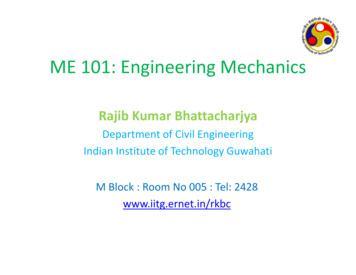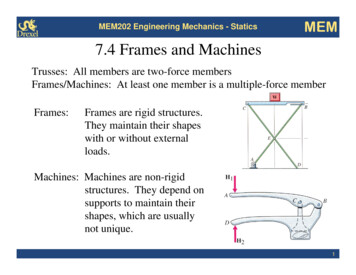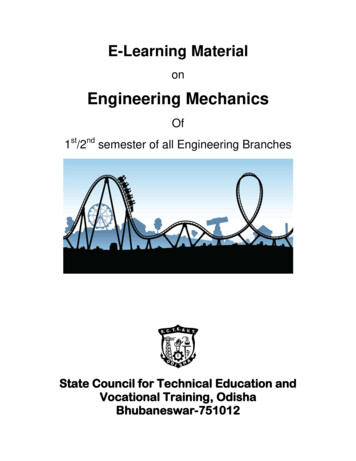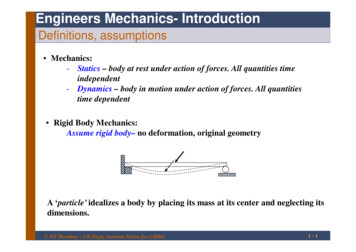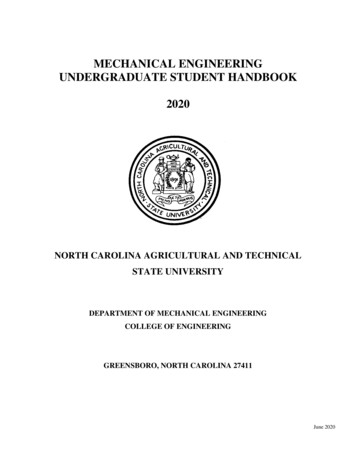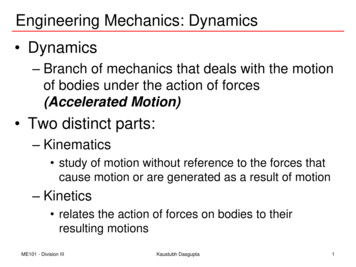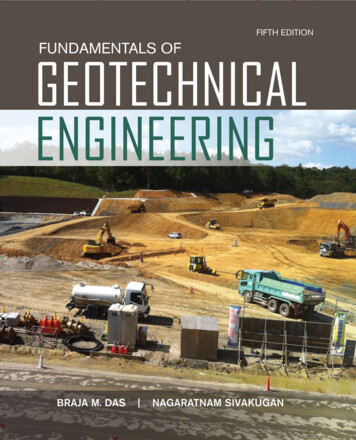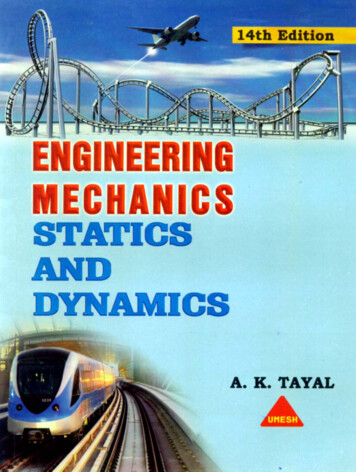
Transcription
ENGINEERING MECHANICS: STATICS AND DYNAMICSDr. A.K. Tayal
ENGINEERINGMECHANICSSTATICSANDDYNAMICSA.K. TayalPh. D.Formerly ProfessorDepartment of Mechanical EngineeringDelhi College of Engineering (Now Deemed University)DelhiCompiled byDeeksha TayalUMESH PUBLICATIONSPublishers of Engineering and Computer Books4230/1, Ansari Road, Daryaganj, Delhi-110 002Phones: (O) 32957898, 43028013
Engineering Mechanics : Statics and DynamicsA.K. TayalPublished by:UMESH PUBLICATIONS4230/1, Ansari Road, Daryaganj, Delhi-110 002Phone : 32957898, 43028013 PublishersFirst Edition : 1989Tenth Edition : 1999Eleventh Edition : 2000Thirteenth Edition : 2005Fourteenth Edition : 2011 (Revised and Enlarged)All rights reserved, No part of this publication may be reproduced, translated ortransmitted (except for review or criticism), without the written permission of thepublishers.ISBN: 978-93-80117-38-6Price : Rs 330.00Laser Typeset by:SARA Assignments, Shahdara, Delhi-110 032.Printed at:Narula Printers, Navin Shahdara, Delhi-110 032.
Preface to the Fourteenth EditionIt gives me a great pleasure to present the Fourteenth Edition of this book on EngineeringMechanics. I express my gratitude for the wide acceptability of the book by the academics aswell as student community and it gives me deep sense of satisfaction. In this new edition, a newchapter on ‘Shear Force and Bending Moment’ has been added. This topic is included to meetthe current requirements of some universities.I again, request for the suggestions and comments for the improvement of the book.DelhiJanuary, 2011Dr. A.K. TAYAL
Preface to the First EditionMechanics is essentially a deductive science based on a few fundamental principles and hasvectorial character. This book has been written with a view to emphasize the vectorial characterof mechanics in such a manner so that the material presented may not require any previousknowledge of mathematics beyond elementary calculus. For this reason, products and derivativesof vectors are not used. A chapter on the ‘Review of Vectors and Forces in Space’, however, hasbeen included as an appendix to introduce the vector approach of the subject. This chapter canbe covered before going on the mechanics of coplanar system of forces.It is a well recognised fact that the teaching of the first course in a subject should be basedon a text book. A systematic, consistent and clear presentation of concepts through explanatorynotes and figures and worked out problems are the main requirements of a text book. This bookhas been written to meet such requirements. Merely stating the principles and explaining theconcepts is not enough; these are to be identified as applicable to the various problems whichmay appear to be strangely different. With this objective, a large number of worked-out problemshave been included in this book. In the most worked-out problems, free-body diagrams have beenseparately drawn with the coordinate axes shown. The equations of equilibrium or of motion,as applicable, have been indicated. Inertia forces have also been clearly identified in a problem.Alternative methods of solution to a number of problems have given or indicated to explain thecomparative merits of the concepts and solution procedures involved. In fact, skill throughrepetition may be as much true here as in occult sciences.I am grateful to many of my faculty colleagues and numerous students at Delhi College ofEngineering, Delhi (now Deemed University) who have contributed significantly by way ofconstructive and useful discussions. The patience of the family members and the encouragementby friends is gratefully acknowledged.I am also tankful to the publishers who have taken keen interest throughout the preparationof the book.Despite may best efforts, it is possible that some unintentional errors may have escaped myattention. I would gratefully acknowledge if any of these is pointed out. Also, any suggestionsand comments for further improvement of the book would be gratefully received and acknowledged.DelhiA. K. TAYAL
ContentsPreface to the Fourteenth EditionPreface1. .132.142.151–6Engineering Mechanics 1Idealization of Bodies 1Basic Concepts 1Fundamental Principles 2Systems of Units 42. CONCURRENT FORCES IN A PLANE2.12.22.32.42.52.62.7viviiForce 7Scalar and Vector 7Addition of Two forces: Parallelogram Law 8Concept of the Resultant of Several Forces 11Resultant of Several Concurrent Coplanar Forces: Polygon Law 12Resolution of a Force into Components 13Resultant of a Several Concurrent Coplanar Forces bySumming Rectangular Components (Method of Projections) 15Equations of Equilibrium for a System of Concurrent Forces in a Plane 18Constraint, Action and Reaction 19Types of Supports and Support Reactions 20Free-Body Diagram 21(a) Equilibrium of a Body Subjected to Two Forces (Two Force Body) 24(b) Equilibrium of a Body Subjected to Three Forces 27Problems 42Moment of a Force 47Theorem of Varignon 47Equations of Equilibrium 49Problems 567–58
xCONTENTS3 . PARALLEL FORCES IN A PLANE59–813.13.23.33.43.53.63.7Parallel Forces 59Resultant of Two Parallel Forces Acting in the Same Direction 60Resultant of Two Unequal Parallel Forces Acting in Opposite Directions 61Two Equal Parallel Forces Acting in Opposite Directions; Couple 61The Resolution of a Force into a Force and a Couple 62Equivalent System of Forces 62General Case of Parallel Forces in a Plane 63Problems 713.8 Distributed Forces in a Plane 733.9 Hydrostatic Pressure: Forces on Submerged Surfaces 75Problems 804 . CENTROID, CENTRE OF MASS AND CENTREOF GRAVITY4.14.24.34.44.54.64.782–107Introduction 82Centre of Gravity of a Body: Determination by the Method of Moments 82Concept of Centroid 84Centroid Two Dimensional Body 85Determination of Centroid and Centre of Gravity: Integration Method 86Centroid of a Composite Plane Figure 88Theorems of Pappus and Guldinus 103Problems 1045 . GENERAL CASE OF FORCES IN A PLANE108–1215.1 General Case of Forces Acting in a Plane: Equations of Equilibrium 108Problems 1186. FRICTION6.16.26.36.46.5122–147Introduction 122Dry Friction 122Laws of Dry Friction 123Rolling Resistance 125Force of Friction on a Wheel 125Problems 1427 . APPLICATION OF FRICTION7.1 Belt and Rope Drives 1487.2 Types of Belt Drives 149148—174
xiCONTENTS7.3 Belt Friction: Ratio of Tensions 1547.4 Centrifugal Tension 1567.5 Initial Tension in the Belt 1587.6 Power Transmitted by Belts 1587.7 Friction in a Square Threaded Screw 1667.8 Disc and BearingProblemsFriction 1701738 . SIMPLE LIFTING MACHINES175–1928.1 Introduction 1758.2 Simple Machines and Definitions 1758.3 Ideal Machine and Frictional Losses 1768.4 Simple Machine : Performance 1778.5 Reversibility of Machines and Self-locking Machines 1788.6 Pulleys and System of Pulleys 1818.7 Wheel and Axle 1858.8 Differential Wheel and Axle 1868.9 Differential Pulley Block 1878.10 Worm and Worm Wheel 1888.11 Simple Screw Jack 1898.12 Single Purchase Winch Crab 190Problems1929 . ANALYSIS OF PLANE TRUSSES AND FRAMES193–2349.1 Engineering Structures 1939.2 Rigid or Perfect Truss 1949.3 Truss : Determination of Axial Forces in the Members 1959.3.1 The Method of Joints 1959.3.2 The Method of Sections 200Problems2169.4 Frames 2209.4.1 Method of Analysis 2209.4.2 Method of Analysis: Example 221Problems23210. UNIFORM FLEXIBLE SUSPENSION CABLES10.1 Cables and Loading 23510.2 Cable Subjected to Concentrated Loads 235235–254
xiiCONTENTS10.3 Cable Uniformly Loaded Per Unit Horizontal Distance (Parabolic Cable) 24210.4 Cable Uniformly Loaded Per Unit Length Along the Cable Itself(Catenary Cable) 250Problems25411. GRAPHICAL ANALYSIS: COPLANAR FORCESAND TRUSSES255–27411.1 Introduction 25511.2 Graphical Conditions of Equilibrium 25711.3 Reaction at the Supports: Determination 25811.4 Special Problem 262Problems26311.5 Graphical Method of Analysis of Simple trusses: Maxwell Diagram 26511.6 Method of Substitution 270Problems27312. MOMENT OF INERTIA275–30812.1 Introduction 27512.2 Moment of Inertia of an Area of a Plane figure with Respect to an Axis in its Plane(Rectangular Moments of Inertia) 27512.3 Polar Moment of Inertia 27612.4 Radius of Gyration of an Area 27612.5 Parallel Axis Theorem (Displacement of the Axis Parallel to Itself) 27712.6 Moment of Inertia of a Composite Area/Hollow Section 28612.7 Product of Inertia 29312.8 Displacement of Axes Parallel to Themselves 29412.9 Rotation of Axis: Principal Axes and Principal Moments of Inertia 29512.10 Moment of Inertia of a Mass (Rigid Body) 301Problems30413. PRINCIPLE OF VIRTUAL WORK13.1 Introduction 30913.2 Principle of Virtual Work 31013.3 Application on the Principle of Virtual Work 31013.4 Potential Energy and Equilibrium 32013.5 Stability of Equilibrium: Stable, Unstable and Neutral 320Problems326309–328
xiiiCONTENTS14. RECTILINEAR MOTION OF A PARTICLE329–378Part A : Kinematics 32914.114.214.314.414.5Introduction to Dynamics 329Rectilinear Motion: Displacement, Velocity and Acceleration 330Graphical Representations 331Motion with Uniform Acceleration 333Motion with Variable Acceleration 334Problems 349Part B : Kinetics 35214.6 Equations of Rectilinear Motion 35214.7 Equations of Dynamic Equilibrium: D’Alembert’s Principle 352Problems 37415. CURVILINEAR MOTION OF A PARTICLE379–427Part A : Kinematics 37915.115.215.315.415.4Introduction 379Position Vector, Velocity and Acceleration 379Components of Motion: Rectangular Components 380(a) Components of Acceleration: Normal and Tangential 382(b) Components of Motion : Radial and Transverse Components 390Problems397Part B : Kinetics 39915.515.615.715.815.915.10Introduction 399Equations of Motion: In Rectangular Components 399Equations of Motion: In Tangential and Normal Components 400Equations of Dynamic Equilibrium (D’ Alembert’s Principle) 401Working Concepts: Curvilinear Motion 402Motion of Vehicles: Level and Banked Roads 415Problems 42316. KINETICS OF A PARTICLE : WORK AND ENERGY16.1 Introduction 42816.2 Work of a Force 42816.3 Energy of a Particle 43316.4 Principle of Work and Energy 43316.5 Work and Energy Principle for a System of Particles 436428–456
xivCONTENTS16.6 Potential Energy and Conservative Forces 43716.7 Principle of Conservation of Energy 43816.8 Power 439Problems 45317. KINETICS OF PARTICLE: IMPULSE ANDMOMENTUM457–47217.1 Introduction 45717.2 Principle of Impulse and Momentum 45817.3 Conservation of Momentum 459Problems46617.4 Angular Momentum 46717.5 Conservation of the Angular Momentum 469Problems47118. IMPACT: COLLISION OF ELASTIC BODIES473–49818.1 Introduction 47318.2 Direct Central Impact 47418.3 Nature of Impact and The Coefficient of Restitution 47518.4 Important Cases of Impact 47718.5 Loss of Kinetic Energy During Impact 47918.6 Oblique Central Impact 48318.7 Problems Involving Energy and Momentum 487Problems49719. RELATIVE MOTION499–51119.1 Introduction 49919.2 Relative Motion between Two Particles: Velocity and Acceleration 49919.3 Relative Velocity: Working Concepts 501Problems51020. MOTION OF PROJECTILE512–53220.1 Introduction 51220.2 Equation of The Path: Trajectory 51320.3 Expressions for Time of Flight, Height, Range and Angle of Projection 51420.4 Motion of a Projectile Thrown Horizontally 51520.5 Motion of a Projectile up an Inclined Plane 516Problems531
xvCONTENTS21. KINEMATICS OF RIGID BODY533–55821.1 Introduction 53321.2 Rotation 53421.3 Linear and Angular Velocity, Linear and Angular Acceleration in Rotation 53521.4 General Plane Motion 53721.5 Absolute and Relative Velocity in Plane Motion 53821.6 Instantaneous Centre of Rotation in Plane Motion 54621.7 Location of the Instantaneous Centre 546Problems55622. KINETICS OF RIGID BODY: FORCE AND ACCELERATION 559–58022.1 Introduction 55922.2 Plane Motion of a Rigid Body : Equations of Motion 55922.3 Relation between the Translatory Motion and Rotary Motion of aBody in Plane Motion 56122.4 D’Alembert’s Principle in Plane Motion 576Problems57623. KINETICS OF RIGID BODY: WORK AND ENERGY581–59323.1 Kinetic energy of a Rigid Body 58123.2 Work of the Forces Acting on a Rigid Body 58223.3 Principle of Work and Energy for a Rigid Body 58323.4 Principle of Conservation of Energy 584Problems59324. MECHANICAL VIBRATIONS594–61824.1 Simple Harmonic Motion 59424.2 Free Vibrations (Without Damping) 598Problems60824.3 Pendulum Motion 609Problems61725. SHEAR FORCE AND BENDING MOMENT25.125.225.325.4619–634Introduction 619Types of Beams and Loading 619Concept of Shear Force and Bending Moment 621Definition of Shear Force and Bending Moment and Sign Convention 622
xviCONTENTS25.5 Shear Force and Bending Moment Diagrams forStandard Cases 624Problems633APPENDIX635–666Appendix 1. Review of Vectors and Forces in Space 635A-1 Definitions 635A-2 Components of a Force 635A-3 Defining a Force by its Magnitude and Two Points on its Line of Action 636A-4 Components of a Vector 637A-5 Vector Operations 641A-6 Angular Velocity 645A-7 Moment of a Force 646A-8 Components of a Vector and Moment about an Axis 648A-9 Resultant of a System of Forces in Space 651A-10 Equilibrium of Spatial System of Forces 653A-11 Types of Supports and Support Reactions(in Three Dimensions) 654Problems 659Appendix 2. Useful Formulae 664INDEX667–671
1CHAPTER1.1IntroductionENGINEERING MECHANICSIt is the science which deals with the physical state of rest or motion of bodies under the actionof forces. Depending upon the nature of the body involved, it can be further divided into mechanicsof rigid bodies, mechanics of deformable bodies (also called strength of materials) and themechanics of fluids.In this book, we shall deal with the mechanics of rigid bodies. Rigid bodies are those bodieswhich do not deform under the action of applied forces. The mechanics of rigid bodies is studiedin two parts, statics and dynamics. Statics deals with bodies at rest and dynamics with bodiesin motion.1.2IDEALIZATION OF BODIESMatter is made up of atoms and molecules. But the real picture of matter as atoms and moleculesis too complex to deal with. So to study the average measurable behaviour of bodies, we assumethat the matter is continuously distributed. Such a description of matter is called a continuum.A continuum can be rigid or deformable depending upon the assumptions we make.Rigid Body. The physical bodies deform, although slightly, under the action of loads orexternal forces. But in many situations this deformation is negligibly small to affect the results.So, the assumption of a rigid body shall mean that the body does not deform or the distancebetween any two points of the body does not change under the action of a applied force.Particle. It is defined as an object whose mass is concentrated at a point. This assumptionis made when the size of a body is negligible and is irrelevant to the description of the motionof the body.1.3BASIC CONCEPTSThe study of mechanics involves the concepts of space, time, mass and force.(i) Concept of space is essential to fix the position of a point. To fully define the positionof a point in space we shall need to define some frame of reference and coordinate system.
Engineering Mechanics Statics andDynamicsPublisher : Umesh Publications ISBN : 9789380117386Author : A K TayalType the URL : http://www.kopykitab.com/product/1275Get this eBook
1.1 Engineering Mechanics 1 1.2 Idealization of Bodies 1 1.3 Basic Concepts 1 1.4 Fundamental Principles 2 1.5 Systems of Units 4 2. CONCURRENT FORCES IN A PLANE 7-58 2.1 Force 7 2.2 Scalar and Vector 7 2.3 Addition of Two forces: Parallelogram Law 8 2.4 Concept of the Resultant of Several Forces 11

